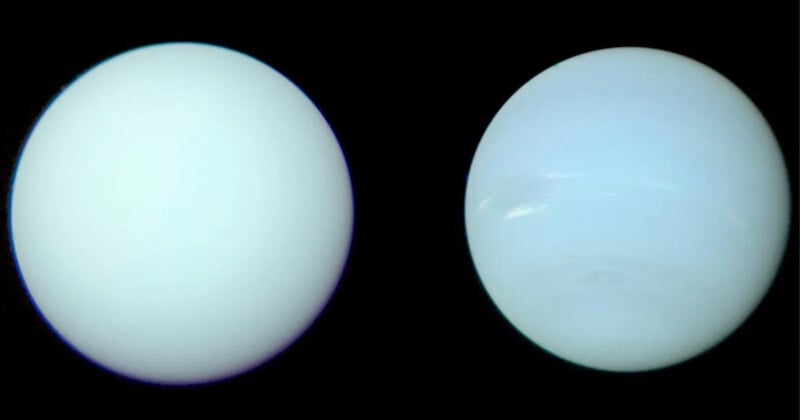
Fresh analysis of images taken by NASA’s Voyager 2 probe has revealed that the planets Neptune and Uranus are actually far more similar in color than previously thought.
Common images of Neptune — the eighth and farthest planet from the Sun — show it in a deep blue. While images of Uranus — the seventh planet from the Sun — show it in a far paler blue.
But in actual fact, Neptune and Uranus are much closer in hue than previously thought, according to study published in the Royal Astronomical Society yesterday (Thursday).
The Voyager 2 probe flew past Neptune and Uranus in the late 1980s, so how has it taken this long to realize the color mistake?
![]()
Both of the remote worlds appear to have a lot in common: they’re roughly the same size and enwrapped in a deep atmosphere made of similar materials. The fact that Voyager 2 showed them in different colors has puzzled scientists for decades.
According to the study from Oxford University, the images of Uranus were published and processed close to its true color. However, the Neptune images were “stretched and enhanced” so terrestrial viewers could see its clouds. The Neptune pictures were made “artificially blue,” says study lead author Patrick Irwin.
“Even though the artificially-saturated color was known at the time amongst planetary scientists — and the images were released with captions explaining it — that distinction had become lost over time,” explains Irwin, a planetary physicist at Oxford University in the U.K.
Irwin and his colleagues used new images of Neptune and Uranus taken on NASA’s Hubble Space Telescope and the European Space Agency’s Very Large Telescope. Using the data from these modern telescopes that capture a better spectrum of colors, the team revisited Voyager 2’s images, rebalanced them, and found that both planets have similar shades of blue.
They both derive their color from a layer of methane contained in the planets’ atmosphere; the methane haze absorbs the red color that emanates from the Sun.
Methane ice particles may also cause Uranus to change its color slightly during its 84-year orbit of the Sun. Images taken by the Lowell Observatory in Arizona from 1950 and 2016 sometimes show the planet to be greener.
“The misperception of Neptune’s color, as well as the unusual color changes of Uranus, have bedeviled us for decades,” Heidi Hammel of the Association of Universities for Research in Astronomy tells Space. “This comprehensive study should finally put both issues to rest.”
